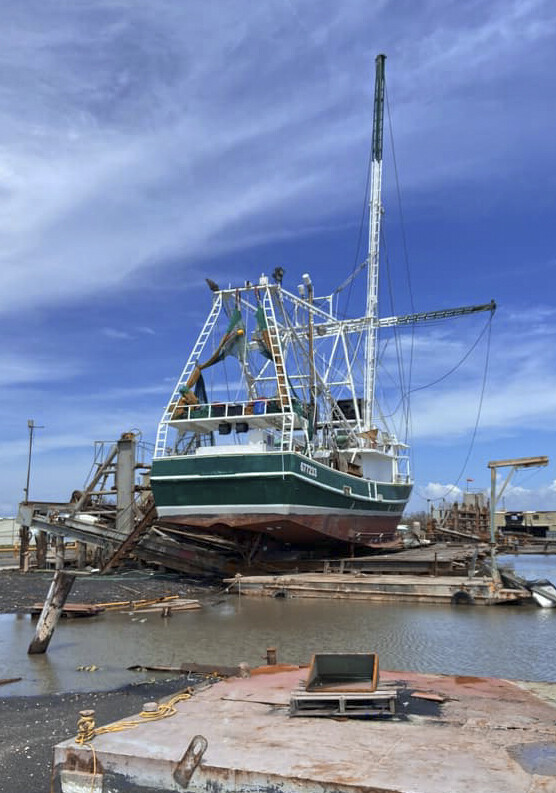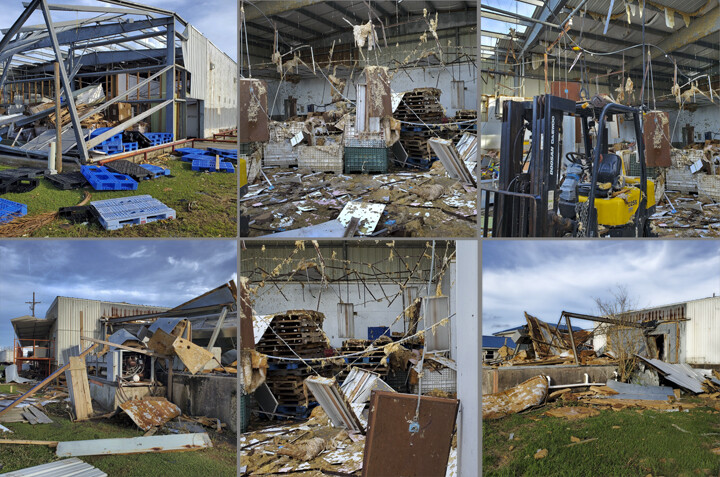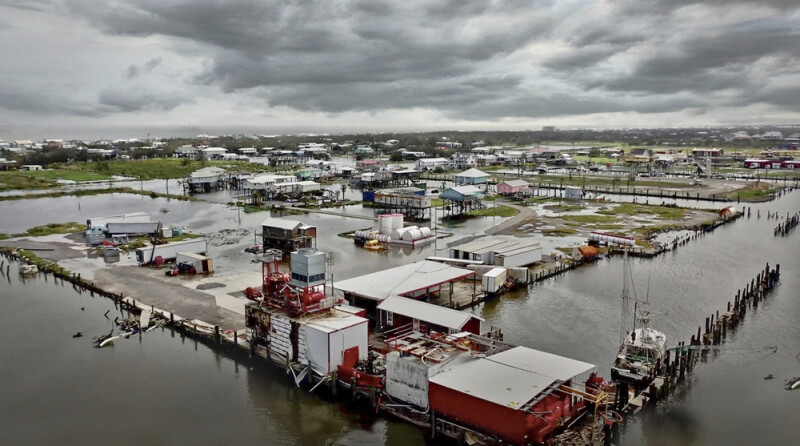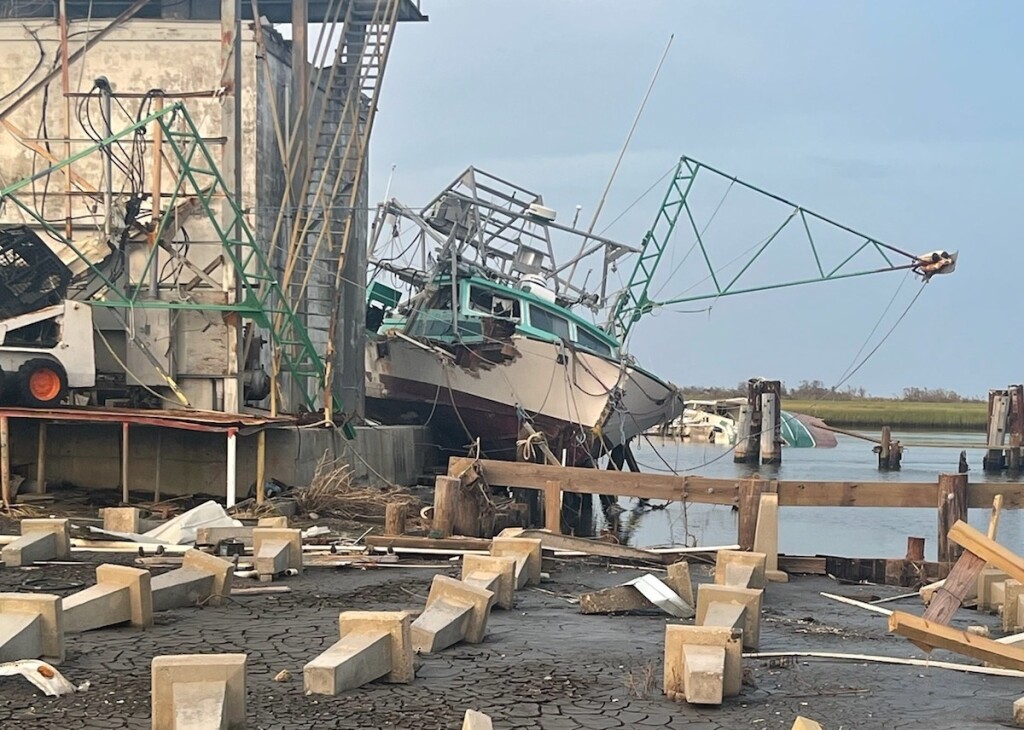Four hurricanes over the course of two years has cost the Louisiana seafood industry almost $580 million in losses to infrastructure, revenue and resources.
A report released by Louisiana Sea Grant and the Louisiana Department of Wildlife and Fisheries documents extreme damage and loss of revenue over all five sectors of the industry: commercial fishermen, recreational fishing, docks, processors and marinas.
Dr. Rex Caffey of LSU Sea Grant led the team that compiled information for the “Infrastructure, Revenue and Resource Losses to Louisiana Fisheries From the Hurricanes of 2020 and 2021” report after a request by the Louisiana Fishing Community Recovery Coalition. The coalition is comprised of members from every aspect of the state’s seafood industry, as well as members of state and federal offices.
Total damage to fisheries infrastructure, estimated at $304.9 million, equates to a 22 percent reduction to the $1.36 billion in appraised value of infrastructure for the five sectors of the analysis. Revenue losses for 22 coastal parishes totaled $155.3 million.
“Our fisheries estimated value of $1.36 billion is just for seafood being caught, harvested and processed. Our seafood industry has an economic impact on our state much greater than just what this report shows. It touches wholesalers, restaurants, mom-and-pop shops, grocery stores and other local markets all over the country and the word,” said Lt. Gov. Billy Nungesser, whose office oversees the Louisiana Seafood Promotion and Marketing Board. “Our seafood industry has supported our state with its great harvests, now it’s our turn to support them and get them the help they need to recover their losses.”

“Our final number relies on the mapping of 8,503 individual business in the Louisiana coastal zone representing every aspect of the seafood industry,” said Caffey. “But it’s one thing to put them on a map. It’s another to try and find out a little bit more about what happened at that location. We were very fortunate to get all the data needed on all four storms from the LSU Coastal Emergency Risk Assessment Center that houses the advanced circulation model.”
Caffey was clear the $1.36 billion is not the damage number, but instead the total value of the infrastructure affected in the evaluations before damages. “We have to estimate this economic baseline before we can know something about what happened to that value because of the storms.”
These business were affected by four storms, so estimating damages based on maximum wind and maximum surge at each of the 8,503 business location required 68,024 storm observations.
“Knowing where they are, knowing what happened at their location, doesn’t say anything about their value,” he went on to explain. “For that we ran detailed business appraisal estimates using trip ticket data for vessels and dealers; and for processors and marinas we used secondary data. When added together, the total value of the five sectors of seafood infrastructure was $1.36 billion.”
Infrastructure damage is estimated at $305 million, equating to approximately a 22 percent reduction in the total appraised value of infrastructure for the five sectors.
“When I ran that number, I had to do a double take. That seems pretty high,” said the team lead. “This is for four storms. I don’t believe it is high, I think it is actually pretty conservative. That number is much more sensible if you think about it as not one, but four storms.”
Of that amount Laura, Delta and Zeta accounted for 30 percent, the rest came from Hurricane Ida. “There were two big storms. But the really big one in terms of economic size was definitely Ida.”

Wind was the story of all four storms. It accounted for 85 percent of damage to vessels, 80 percent of damage to dealers, 80 percent for processors, 89 percent for charter and 54 percent for marinas, where surge was more dominant in the most seaward locations. These numbers differ from earlier storms like Katrina and Rita, where surge dominated.
Infrastructure
All locations in the report were integrated into Geographic Information System. Information came from Wildlife and Fisheries license and permit records or the Louisiana Department of Health. Storm information came from LSU Coastal Emergency Risk Assessment Center. This evaluation was based on actual revenue, so it is primary data for vessels and dealers; the rest relied on secondary data from economic studies.
A linear model defined the upper bound of asset damage, and a nonlinear model was used to estimate the lower bounds. These damage curves were developed from the survey data and was applied to the broader population. The infrastructure damage ranges were developed for two years, for the three hurricanes in 2020 and Ida in 2021.
There were 5,739 seafood harvesting vessels geocoded in coastal Louisiana. To understand the value of the businesses, trip ticket records were used for income capitalization appraisal averages for 2018-20. For cases where trip ticket information was insufficient, a market value appraisal of the length of the vessel was used as a secondary evaluation to approximate value. Docks and dealers were also valued on trip tickets.

All damage numbers were dampened by an assumed 20 percent evacuation rate collected from the survey, information never included in previous economic damage assessments.
“You see a trend the 2021 damage values are much larger because Ida hit an area more heavily populated; it was a bigger storm with a larger impact area,” said the economist.
Seafood processors were more difficult to value because of lack of primary information. Using business permits fees the committee was able to estimate revenues for the given years. Charter fishing losses were evaluated from cost of earning data over the years.
Marinas’ business appraisal was from cost and earnings from previous sources, including a recent covid study done the previous year. That information was extrapolated back to the larger population based on size.
Combined infrastructure losses for each sector:
Charter Fishing – $31.2 million
Docks and Dealers – $77.4 million
Marinas – $44.6 million
Processors – $99.7 million
Louisiana Marina Association Representative Chris Moran of Port Fourchon feels the damage numbers for his sector are very low. He is currently in the process of rebuilding his $5 million in losses from Ida and does not expect to reopen till May of this year.
“We have been closed for five months now, and we are not the only one,” he said in a recent interview. “The $44.6 million in infrastructure damages might be accurate for larger marinas like mine, but I feel there may be host of smaller operations’ infrastructure and revenue losses may not be accurately classified in the report.”
Revenue
Revenue loss was done in a similar way. The baselines were the same, but wind and surge was averaged at the parish level because no direct revenue was available for all five categories. In addition, losses were not done by a single year, but instead a combined loss for both years from the storms.
The combined revenue losses for the 22 coastal parishes totaled $155.3 million. Two parishes, Cameron and Calcasieu, exceeded the 35 percent revenue threshold. That threshold is never measured on a parish level.
“Federal disaster declarations are always measured on a management level for an entire species. There is little bases for a declaration for a parish,” said Caffey. “Now should there be? I know in agriculture there are county and parish level declarations.
“Four hurricanes hit one state in 12 months and two days. These areas clearly had more than 35 percent in projected losses. Time will tell to see how these hold up.”

Resources
While examining commodities the committee found that resource losses estimated to be at $118.5 million over the two-year period. The figure was derived from field surveys of LDWF biologists and restitution values obtained from Natural Resource Damage Assessments.
Brown shrimp was the only species under the models that came close to exceeding or right at 35 percent project loss level. Caffey says he is not sure that is going to hold up, and instead is more interested in watching white shrimp.
“The reason I say that is because the model didn’t differentiate the season for when storms occurred,” he explained. “Brown shrimp was pretty much over when Ida hit, and white shrimp had yet to start. We will continue to watch these over the next year to see if these thresholds are met at the commodity level.”
In addition, a resource mortality report was done externally to the economic report. That data was brought over and added to the total score of infrastructure revenue.
Conclusion
“What we have here is a story of two big, big storms amongst the four hurricanes that drove the majority of the damages. Going forward a list of short-, medium- and long-term priorities needs to be developed. Unfortunately, this report does not address this issue, it speaks to economic and damage assessment,” said Caffey.
“The information provided by this report will be critical for our seafood industry as they seek recovery assistance from state and federal lawmakers,” said Patrick Banks, assistant secretary of Louisiana Department of Wildlife and Fisheries. “Having a thorough and scientifically defensible damage estimate helps Louisiana not only show the impacts from hurricanes, but clearly documents the enormous value of our coastal fishing industries, both recreational and commercial.”
Banks feels these industries are a large part of the cultural heritage in Louisiana, and helping them recover is vitally important. “The team of scientists and economists from both LDWF and LSU worked extremely hard on this initiative, and they couldn’t have completed the task without the cooperation of the industry leaders on the LFCRC and members of the fishing industries.”
“Our fishermen have taken a pounding over the last several years. Hurricanes, floods, unfair trade practices and government over-regulation have taken their toll,” said Louisiana Rep. Garret Graves. “This report verifies what we have been saying about the hurricane impacts and clearly justifies the fisheries assistance we’ve requested. We are going to get assistance to our fishing communities.”

“The LFCRC has been discussing numerous challenges that need to be addressed in the future, including: the availability and affordability of both marine insurance and traditional insurance; exploring possible novel or creative alternatives like fisheries insurance, similar to crop insurance; the ongoing challenges to vessel evacuation options; and the need for infrastructure hardening,” said the coalition Chair Harlon Pearce.
“We have to have a list of priorities developed before the seafood industry asks for economic damage compensation from our legislators.”







